The Best Way to Cool Whole House Without Air Conditioning
Tin can you cool a house without air conditioning?
(Epitome credit:
Getty Images
)

As global summer temperatures rising, more buildings are installing free energy-hungry air conditioners – a major contributor to climate change. Just are there ways to cool buildings downwards without turning the AC on?
A
At starting time sight, the view could be mistaken for the rolling hummocks of Hobbiton, right down to the perfectly circular doors opening out of the lush green hillside. Only the doors are made of drinking glass, and inside them are not cosy hobbit holes just an array of big mechanical steel artillery and levers property some of the doors ajar.
These hills are part of the roof of the California Academy of Sciences in San Francisco, US. The undulating greenish roof is one of a serial of engineering science and design features that make the academy 1 of the largest passively ventilated spaces in the US. This means that fifty-fifty in the peak of summer, the majority of this building relies on clever manipulation of the elements to stay cool, with adjacent to no air conditioning.
You might as well similar:
- 10 simple means to human action on climatic change
- The animals that will survive climate change
- Could wooden buildings aid fight climate change?
Roofs like these are 1 manner that architects, engineers and designers are rethinking buildings to find ways to keep them absurd without ac. The challenge is condign increasingly urgent; it has been yet another scorching year, with heatwaves steamrolling Australia, southern asia, N America and Europe. To deal with heatwaves, made more frequent by climatic change, the number of Air-conditioning units is expected to more than than triple worldwide by 2050. Likewise every bit guzzling huge amounts of electricity, AC units contain refrigerants that are potent greenhouse gases. These refrigerants are in fact the fastest-growing source of greenhouse gas emissions in every country on Earth.
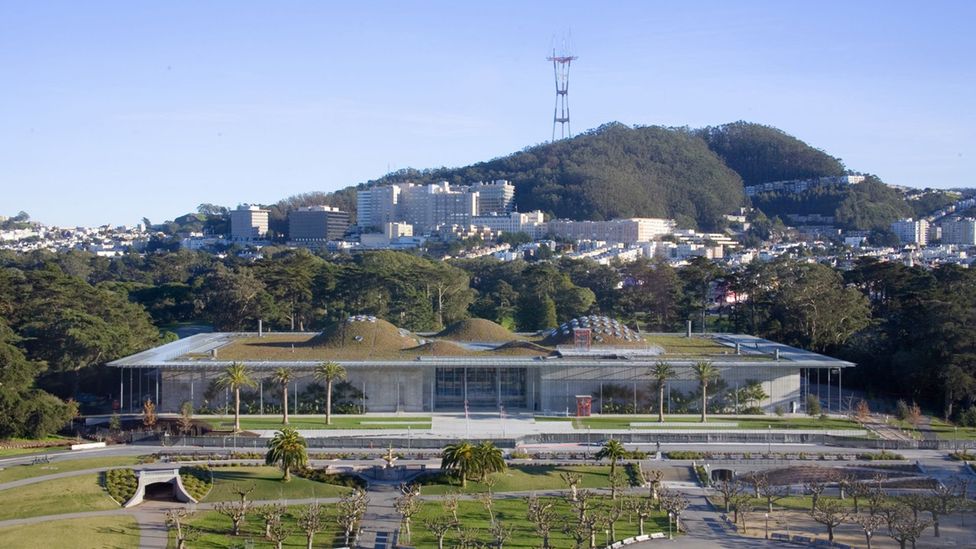
The intriguing blueprint of the California Academy of Sciences is congenital to promote cooling air movement around the building (Credit: Cody Andresen)
But there are alternatives, and enough of them. From ancient building designs that have been tried and tested over seven,000 years, to the cutting-edge technologies at the California Academy of Sciences, information technology is possible to create buildings that stay absurd with nigh no energy requirements at all.
At the academy, the roof's grassy domes divert the natural period of air inside the building. As the wind blows beyond, one side of the hills is at negative pressure level, which helps to suck air through the automatically controlled roof windows and into the building. The fact that the roof is covered with vegetation also helps to bring the temperature down in the space below, as well as providing a habitat for wildlife above.
"We first off with the attitude of how far can nosotros go in designing the building on the assumption that nosotros're not going to have Air conditioning," says Alisdair McGregor, global leader for mechanical engineering at Arup, who was involved in the building'south design. But it's rare to fully climate-command the whole building past that approach, he adds. There might be constraints imposed by a noisy motorway next to a building, making it unfeasible to open the windows. Or the building could accept a lot of hot equipment or people with particular needs, such equally in a hospital. But at least it ways that AC, along with its costs and emissions, is reduced to the bare minimum.
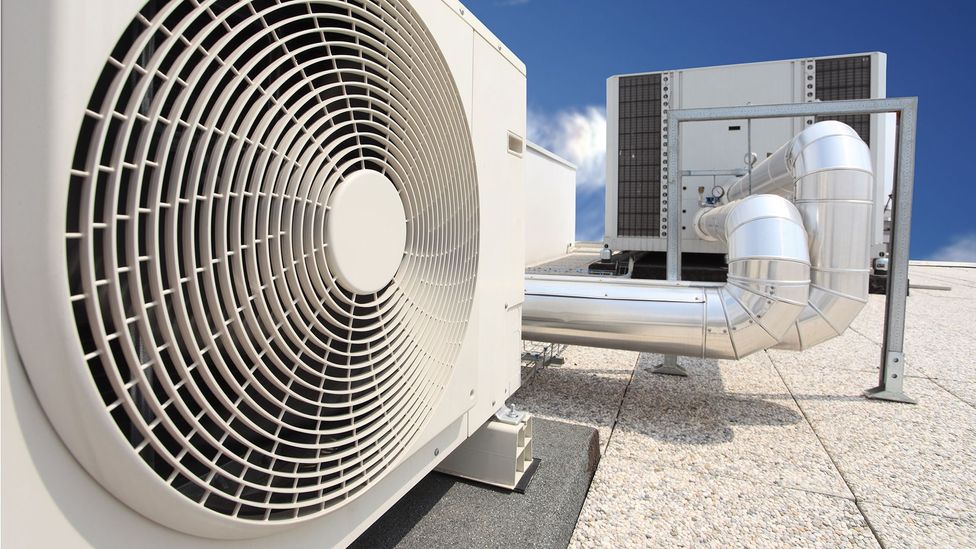
Conventional air conditioning releases greenhouse gases into the atmosphere, contributing to global warming (Credit: Getty Images)
The California Academy of Sciences is a pinnacle in passive design. Simply it was also an nearly half-billion-dollar project with access to some of the best engineers and architects in sustainable development. What about the much more ordinary, everyday buildings that virtually of us spend the bulk of our fourth dimension in – can passive cooling also brand them heatwave-proof?
Water
One of the simplest forms of passive cooling makes utilise of the temperature alter in the air when water evaporates. H2o requires free energy to get from the liquid country to vapour, and it takes that energy from the air in the form of heat.
"Evaporative cooling is a natural miracle," says Ana Tejero González, an engineer at Valladolid University in northern Espana. "Nosotros can see a lot of examples in nature where this happens." It tin can cool a surface also as a body of air, such equally your skin when you sweat, or a domestic dog's tongue when it pants.
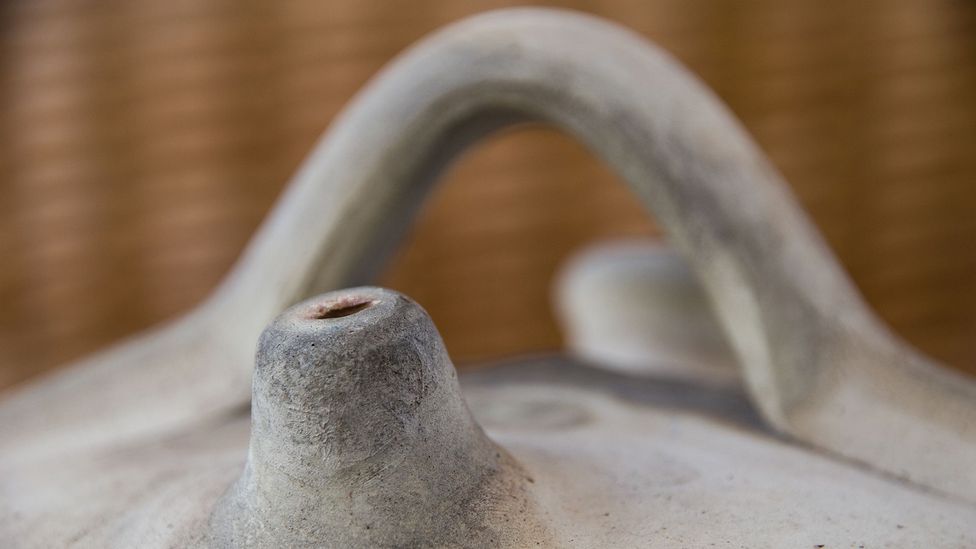
The botijo aids in evaporative cooling by allowing water to permeate through its dirt walls (Credit: Getty Images)
In González'due south region of Espana, a traditional vessel called a botijo uses the same principle. The botijo is a big pot made of porous clay and used to acquit water or wine, which farm labourers would take out into the fields. Small amounts of the drink evaporates through pores in the clay walls, keeping the liquid inside absurd even under the hot Castilian sun.
In architecture, the use of evaporative cooling goes dorsum to ancient Egypt and the Romans. But some of the more elaborate examples are from Arabic architecture and a construction chosen the mashrabiya. A mashrabiya is an ornate, traditionally wooden lattice carved with intricate designs, plant on the outside or the within of a building. Besides as providing shade, in the summer the mashrabiya would be home to porous earthenware pots – similar the botijo – filled with h2o. These would assist to cool the room as a breeze flowed through the mashrabiya and over the pots.
But there are even simpler means to harness evaporative cooling in a building or outside infinite. A torso of water in a courtyard – a pond, fountain or runnels of water flowing throughout the space – all do the same job. And inside, placing an earthenware pot of water almost a window or draughty spot can help to absurd the place down.
Earth
If currently temperate regions of the global north are going to get equipped to deal with routine extreme heat, there is a lot to be learned from buildings, both ancient and modern, in the global south, says Manit Rastogi, a founding partner at the architectural firm Morphogenesis, based in Republic of india. "This function of the world has e'er been hot," says Rastogi. Passive cooling systems have been a matter of necessity for thousands of years. "Near of the architecture we've done traditionally here are phenomenal examples of achieving cool conditions without mechanical means."
Fifty-fifty in exposed, hot and arid climates, cooler temperatures are never too far abroad. In Jaipur, the capital of Rajasthan state in northern Republic of india, daytime temperatures regularly attain up of 40C in the summer months. But just a few metres below ground, the temperature of the earth in the region remains a much gentler 25C, even through the fiercest summer heat.
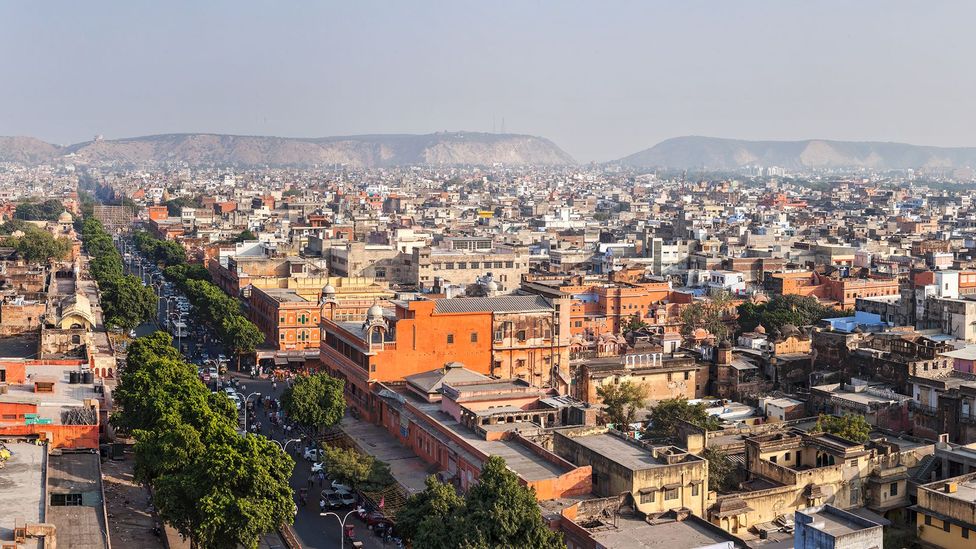
In the city of Jaipur, Bharat, summertime temperatures attain 40C and higher (Credit: Getty Images)
The solution is to dig down, says Rastogi, who designed the Pearl Academy of Manner in Jaipur using this principle. Rastogi and his colleagues used a traditional Indian stepwell, or baoli, within an internal shaded courtyard at the academy. Banks of grayness stone steps lead downward seamlessly to the border of a large, nevertheless pool of collected rainwater and treated wastewater from the building. The pool, cooled by the subterranean temperatures, absorbs a substantial amount of estrus from the courtyard, keeping the air fresh. "Digging into the world is very, very effective," says Rastogi.
While it might be an bonny solution, digging an enormous well within your property isn't necessary to make apply of the same phenomenon. Commercial basis source heating and cooling systems likewise make use of the earth's more or less stable year-round temperature by pumping a liquid through buried pipes outside. The liquid'southward temperature falls to that of the globe, and is then pumped back inside, where it can run through underfloor pipes to cool the firm down. These systems can exist used to both rut buildings in winter and to absurd them in summer. Global uptake of them for heating has been slow, only they are condign increasingly popular for cooling, particularly in northern Chinese cities in the summer.
Besides its baoli, the Pearl Academy of Way in Jaipur uses a few other tricks to keep the temperature down. From the outside, the building is a elementary rectangular shape, which may not expect very elegant merely has the benefit of maximising the amount of internal infinite for external surface area, as every square foot exposed to the Sun absorbs heat. The building is shrouded in a jaali, or perforated stone "peel" about four feet from the outer walls, which helps to shade the edifice and buffer the temperature. "A lot of these strategies are about being in affect with nature and understanding how it works," says Rastogi. "Understand the site and that item typology, and the job volition be a lot easier."
The effect is that interior of the university is a fairly tepid 29C even in the hottest months, when temperatures outside are regularly more than 40C. This allows air-conditioning to exist used very modestly, when it is necessary at all.
Current of air
The city of Yazd in Iran is known equally "windcatcher city". The windcatchers are towers with arched glassless windows sat atop flat-roofed buildings, facing the direction of the prevailing winds. For centuries, these towers take caught the cakewalk and channelled information technology downwards to the dwellings, split into channels by a series of blades within the tower. The arched roof of the windcatcher helps to encourage circulation of air even when there is not a strong cakewalk blowing. Sometimes the air flows over a basin of water, or even a deep reservoir in a domed chamber, to encourage further cooling.
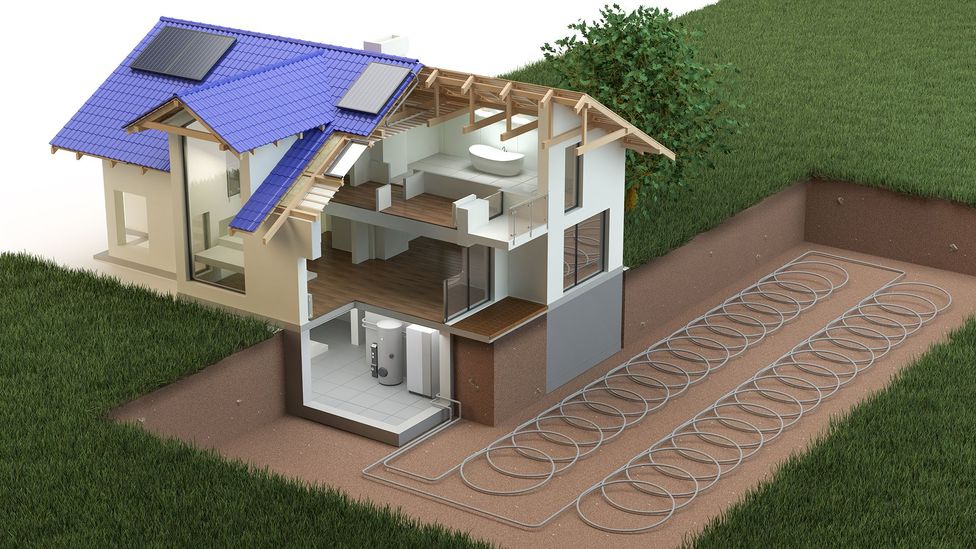
Basis source heating and cooling systems use the globe'southward stable subterranean temperature to regulate the indoor climate (Credit: Getty Images)
The windcatchers of Yazd are among the virtually varied and artistic in the Eye E, co-ordinate to research by Mahnaz Mahmoudi Zarandi, an assistant professor of architecture at the Qazvin Islamic Azad University in Tehran. An analysis of Yazd'due south windcatchers establish that the most effective models decreased air temperature indoors from 40C to 29.3C.
In ordinary buildings that aren't fortunate enough to have a windcatcher built in, at that place are still options, says Arup'south McGregor. Having windows open up on dissimilar sides of a building at different heights can help to pull air through. "You sometimes see that upshot too much, and you lot virtually get a howling gale through," says McGregor. "For example, a tall atrium with an opening at the peak and a door at the bottom. Simply by varying the openings, you can command the air menstruation through the building."
Concrete jungle
Thinking on the scale of individual buildings, even so cleverly designed, can only bring the thermostat down so far. But understanding the way that buildings interact with the balance of the urban landscape tin help bring it down a notch farther.
The London skyscraper known as the "walkie-talkie" provides a lesson in how not to do this. The building has one giant concave face. While it might look fancy, there is a reason that inward-curving skyscrapers aren't very common. Before the building was completed, it was discovered that the vast shiny concave surface acted like a magnifying glass, focusing the Sun'due south rays on one small-scale surface area. That focus happened to be a few metres of pavement exterior a hairdresser'south and a Vietnamese eating house. The result was temperatures so hot that paint melted, motorcar parts blistered and buckled, tiles shattered and a doormat fix on fire.
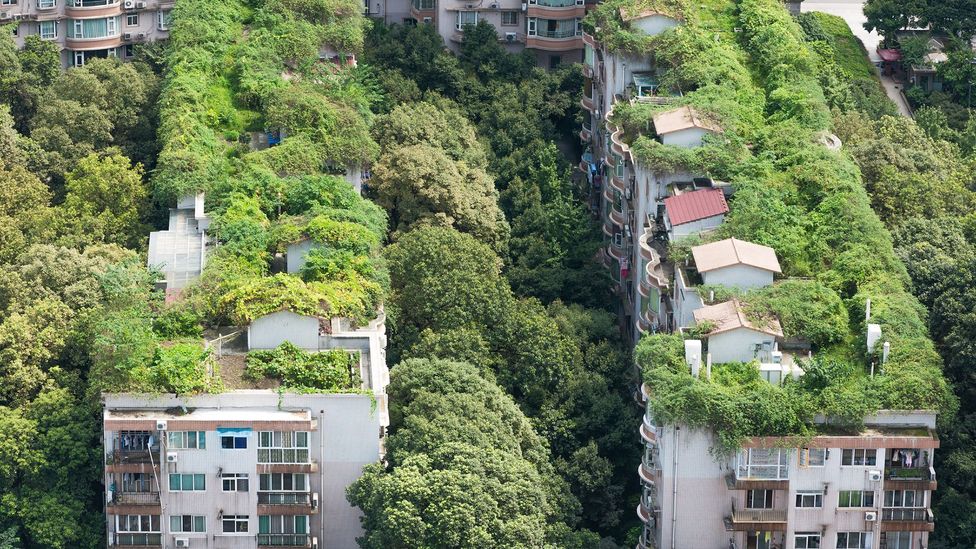
Lush vegetation helps to continue cities such as Chengdu, China, cool in summertime (Credit: Getty Images)
The problem has now been fixed thanks to the improver of a last-infinitesimal brise soleil, or giant sunshade fabricated of aluminium slats. But information technology shows how profoundly a pattern tweak can change the temperature of the urban mural. Fifty-fifty without skyscraper-sized magnifying spectacles scorching the pavements, there is the issue of the urban heat island effect – where tedious, gray concrete absorbs the Sun'due south heat and radiates information technology dorsum out onto sweltering pedestrians, similar a highly unnecessary hot water bottle.
Nosotros might think of the heat-island effect as a necessary evil of summer in the metropolis. Merely urban spaces can exist adapted to reduce it. One of the nigh constructive means is past bringing in some vegetation. Nosotros all know this intuitively – it is the difference between the shady tree-lined boulevards of a city similar Palma, Majorca, and the blistering exposed sidewalks of New York.
In Medellín, Republic of colombia, the city authorities take been experimenting with "green corridors" through the metropolis. They developed thirty light-green corridors in otherwise grey parts of the urban center, making apply of the verges of 18 roads and 12 waterways. These green strips lowered temperatures by 2C. A study by Monica Turner, an ecologist at the Academy of Wisconsin-Madison, showed that even broader tree embrace tin can reduce urban temperatures by upward to 5C.
Many cities are taking similar steps. Milan's municipal regime program to constitute three million copse in the city by 2030. Melbourne, Australia, has also begun a tree-planting program to keep the metropolis liveable through futurity heatwaves. And new cities, such every bit China'southward Liuzhou Forest City are able to weave in vegetation comprehend from the offset.
Exit strategy
Of class, even in a passively cooled edifice in a well-designed city, sometimes these design measures are not going to be enough. In a infirmary full of rut-generating equipment and vulnerable people, there volition be cooling requirements that go beyond what passive systems can achieve. "Here, we don't care near the energy so much – we just demand to achieve the right thermal atmospheric condition indoors," says Valladolid University's Tejero González.
Merely the lesser line is that conventional air conditioning should exist a last resort, not a crutch. Perhaps the virtually promising matter well-nigh passive cooling, McGregor adds, is that it offers a way out of the vicious bike we are currently stuck in with air conditioning: using a technology to proceed absurd that actually contributes to heating the world upwardly.
--
Join one million Future fans past liking united states on Facebook , or follow us on Twitter or Instagram .
If you liked this story, sign up for the weekly bbc.com features newsletter , chosen "The Essential List". A handpicked option of stories from BBC Future, Civilisation, Worklife, and Travel, delivered to your inbox every Friday.
conleydayfulgaid1962.blogspot.com
Source: https://www.bbc.com/future/article/20190822-are-there-alternatives-to-air-conditioning
0 Response to "The Best Way to Cool Whole House Without Air Conditioning"
إرسال تعليق